
10 Best States (and Cities!) to Invest in Section 8 Housing
Investing in Section 8 housing can be a smart strategy for real estate investors looking for steady rental income. However, the federal program, which provides rental assistance to low-income individuals, offers varying opportunities and challenges for investors depending on the state and city.
In this article, we’ll examine the 10 best states to invest in Section 8 housing—as well as 10 states where investing in Section 8 may present increased challenges.
We’ll also look at the U.S. cities with the highest fair market rents (FMRs) and vacancy rates, and states with the most favorable landlord-tenant laws, and how those things affect Section 8 investing in those locations.
Let’s get started.
10 Best States to Invest in Section 8 Housing
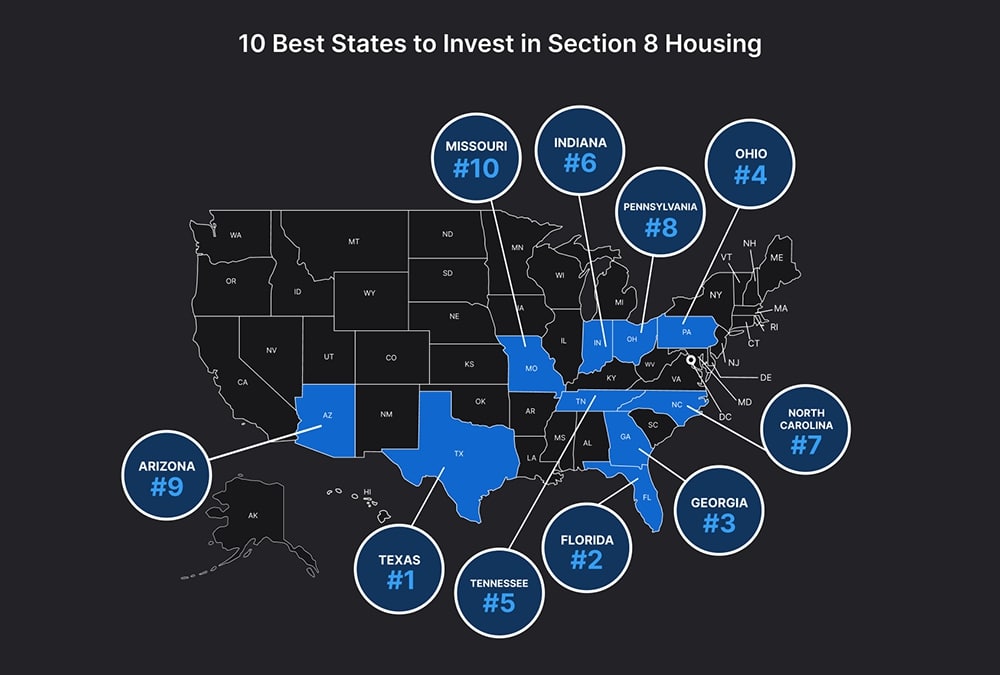
These 10 states offer a combination of affordability, strong rental demand, and landlord-friendly policies, making them ideal for Section 8 housing investments. Investors should consider local market conditions, Section 8 program specifics, and long-term growth potential when making investment decisions.
1. Texas
Texas has a large and growing population, with strong demand for affordable housing. Cities like Houston, Dallas, and San Antonio have well-established Section 8 programs and offer high rental yields.
Pros: Favorable landlord-tenant laws, relatively low property prices, and high rental demand.
2. Florida
Florida's warm climate and booming population, especially among retirees and lower-income families, make it a great place for Section 8 housing. Cities like Miami, Orlando, and Tampa have strong demand for affordable rentals.
Pros: High rental demand, a variety of housing markets, and relatively affordable property prices.
3. Georgia
Atlanta and other major cities in Georgia face a shortage of affordable housing, driving demand for Section 8 properties. Investors can benefit from high occupancy rates and a steady stream of renters.
Pros: High rent-to-value ratio, expanding population, and supportive government housing programs.
4. Ohio
Ohio has affordable property prices, and cities like Cleveland, Cincinnati, and Columbus offer stable rental income through Section 8 housing. Ohio's affordability attracts both tenants and investors.
Pros: Low property prices, steady demand for affordable housing, and supportive local housing authorities.
5. Tennessee
Tennessee’s rapidly growing cities, such as Nashville and Memphis, face increased demand for affordable housing. The state's landlord-friendly policies and affordable real estate make it an attractive option for investors.
Pros: Strong rental demand, affordable property prices, and favorable landlord laws.
6. Indiana
Indiana, particularly Indianapolis, offers affordable housing markets with solid rental yields. The state has a growing demand for affordable housing, and Section 8 rental assistance is widely used.
Pros: Low cost of living, affordable properties, and a steady rental market.
7. North Carolina
North Carolina’s major cities, including Charlotte and Raleigh, have seen an influx of residents, increasing demand for affordable housing. The state offers good opportunities for Section 8 housing investment.
Pros: Growing population, high rental demand, and a range of housing markets from urban to suburban.
8. Pennsylvania
Pennsylvania, especially cities like Philadelphia and Pittsburgh, has a strong need for affordable housing. Investors can find Section 8 tenants easily, and the state's rent payment standards can provide solid returns.
Pros: Affordable real estate prices, high demand for rentals, and a well-managed Section 8 program.
9. Arizona
Arizona’s expanding cities, like Phoenix and Tucson, have a high demand for affordable housing options. The state’s consistent population growth has increased rental demand, making Section 8 housing a stable investment.
Pros: Favorable climate for population growth, strong rental demand, and relatively low property taxes.
10. Missouri
Missouri offers affordable property prices, especially in cities like St. Louis and Kansas City. The demand for Section 8 housing is high, and landlords benefit from consistent rental payments.
Pros: Low property prices, good rental demand, and a favorable investment climate.
10 States Where Section 8 Investors Face Increased Challenges
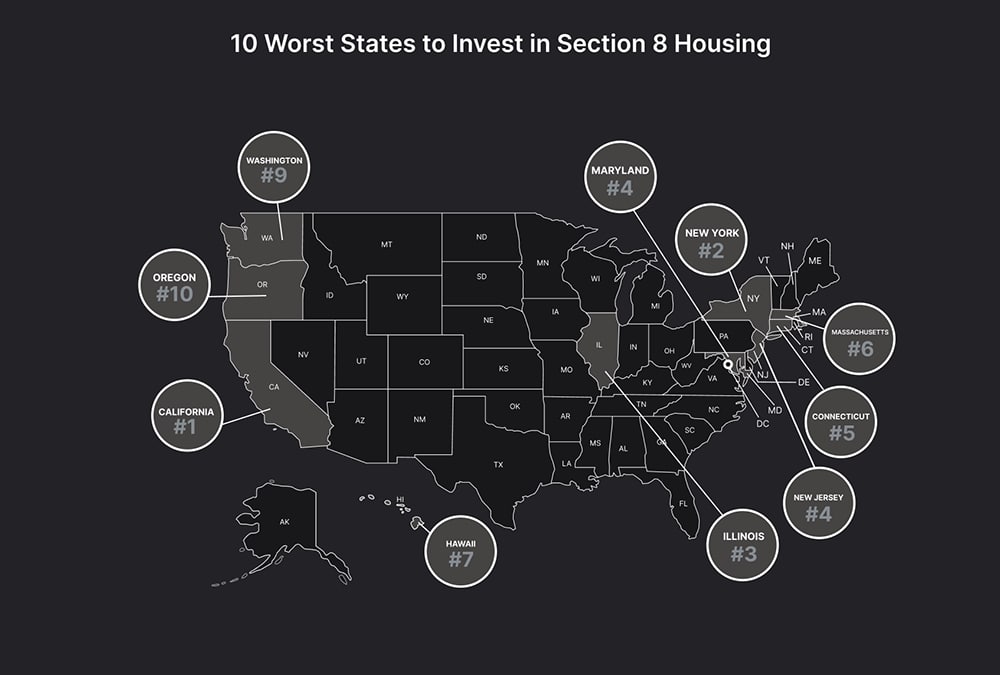
The following states may pose challenges due to weak rental markets, unfavorable landlord-tenant laws, or low Section 8 demand. These factors can affect profitability and stability for investors.
While some of these states may still offer good opportunities in specific cities or neighborhoods, the challenges tend to outweigh the benefits for many investors. It’s important to consider the local legal and economic landscape before committing to Section 8 housing in these states.
1. California
California's strict tenant protection laws can make it difficult for landlords to manage Section 8 properties. Rent control, eviction moratoriums, and high property prices reduce profitability, contributing to California’s status as the most challenging state for Section 8 investors.
Cons: High property costs, stringent tenant laws, and limited returns due to rent caps.
2. New York
Like California, New York has strict rent control laws, especially in cities like New York City. Tenant-friendly regulations can make it hard for landlords to operate Section 8 properties profitably.
Cons: Complex rent control, high property taxes, and a challenging eviction process.
3. Illinois
Illinois, particularly Chicago, has strict landlord-tenant laws, which can make property management more difficult. High property taxes and declining population in some areas also pose challenges.
Cons: High property taxes, population decline in certain regions, and complex housing regulations.
4. New Jersey
New Jersey’s high property taxes and stringent tenant laws make it less favorable for Section 8 investors. The state also has a slow eviction process, making property management difficult.
Cons: High property taxes, strict eviction laws, and relatively high cost of living.
5. Connecticut
Connecticut has high property taxes and strict tenant laws. The state’s sluggish population growth and low rental demand in some areas make it a less attractive option for Section 8 housing.
Cons: High property taxes, weak rental demand, and challenging landlord-tenant laws.
6. Massachusetts
Massachusetts, especially in Boston, has high property costs and strict tenant protection laws. The high cost of entry and complex regulations can make Section 8 investments less profitable.
Cons: High property prices, strict rent control laws, and a tenant-friendly legal system.
7. Hawaii
Hawaii’s real estate market is among the most expensive in the country, making it difficult for investors to achieve reasonable returns on Section 8 housing. The state also has tenant-friendly regulations.
Cons: Very high property prices, low rental yields, and strict housing regulations.
8. Maryland
Maryland, particularly in the Baltimore area, has high property taxes and strict tenant laws. Although there’s demand for affordable housing, managing properties can be difficult due to complex regulations.
Cons: High property taxes, tenant-friendly laws, and a slow eviction process.
9. Washington
Washington state, particularly in cities like Seattle, has high property prices and strict tenant protections. The cost of purchasing property often outweighs the potential rental income from Section 8 tenants.
Cons: High cost of real estate, complex housing regulations, and strong tenant protections.
10. Oregon
Oregon has implemented strict rent control laws, making it harder for investors to maximize their rental income. The state also has tenant-friendly eviction laws, adding more challenges for landlords.
Cons: Rent control, eviction moratoriums, and high property prices in cities like Portland.
What Exactly Is Section 8?
Before we go further, let’s take a quick look at what exactly Section 8 is, and the two main types. Section 8 is administered by the U.S. Department of Housing and Urban Development (HUD), provides housing assistance to low-income families through subsidies. Units can be houses, apartments, condos, and other multifamily dwellings.
The term "Section 8" refers to the broader housing assistance program authorized by Section 8 of the Housing Act of 1937, which includes both project-based and tenant-based assistance.
Here’s a brief look at the two main types:
Voucher-based: Officially the Housing Choice Voucher Program (HCVP), tenants receive Section 8 vouchers to rent eligible, private market properties of their choice, with HUD covering a portion of the rent. Tenants can choose their own housing, and the government pays a portion of the rent directly to the landlord.
Property-based: The subsidy is tied to specific properties, meaning tenants must live in designated Section 8 housing to receive assistance.
For investors, voucher-based properties offer flexibility, while property-based Section 8 can provide more stable, long-term tenants since subsidies are attached directly to the property.
How to Determine the Best States and Cities to Invest in Section 8 Housing
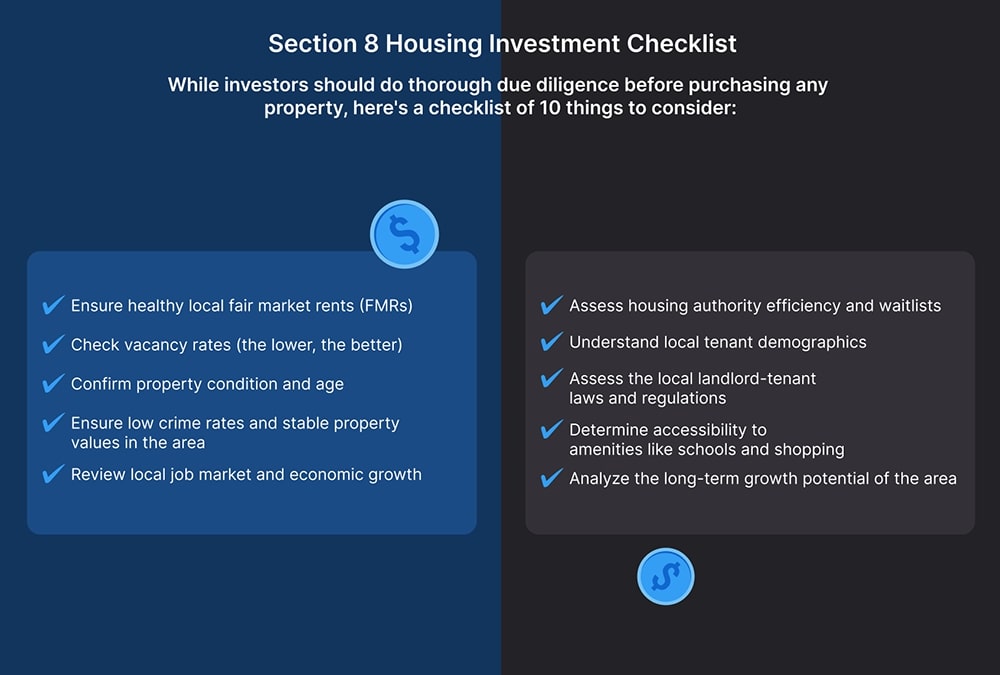
Our list of the 10 best states to invest in Section 8 housing, and the 10 states where investing in Section 8 properties would present additional obstacles, takes numerous factors into consideration.
While investors should do thorough due diligence before purchasing any property, there are some general things to consider when determining which states and cities are best suited for Section 8 investing.
Here are 10 things to consider when deciding where to invest in Section 8 properties:
1. Local Fair Market Rents
Research the fair market rents (FMRs) in the area to understand potential rental income. FMR is the amount determined by HUD as a reasonable cost to rent a modest apartment in a specific area, considering local market conditions and rent data.
Generally, the higher the fair market rent, the better conditions are for property investors. Later in this article, we’ll look at the top 20 U.S. cities with the highest fair market rents.
2. Vacancy Rates
Evaluate the area's vacancy rates to gauge demand for rental properties. Sources like HUD.gov and the U.S. Census Bureau American Housing Survey can provide valuable insights into this to help investors make informed decisions. We’ll dive into this later in the article, and examine trends in vacancy rates that can be helpful for investors.
3. Property Condition and Age
Consider the age and condition of the properties available. Older homes may require more maintenance, which can lead to higher overhead costs for homeowners and investors.
Especially for older units, consider which appliances could be removed before renting—rather than waiting for them to break and need to be replaced. And if they’re already broken or in bad condition, consider just removing them. These may include the refrigerator, washing machine, dryer, dishwasher, or other value-adds.
However, offering more than the basic requirements can attract tenants who are less likely to cause hassles.
4. Neighborhood Stability
Look for neighborhoods with low crime rates and stable property values. For lower crime rates, it may be good to look in the suburbs or outside of city centers—while you may lose some money due to lower rent, it will likely be worth it to avoid potential crime, turnover, and property destruction.
Resources like NeighborhoodScout, City-Data, or the local police department’s online crime map can provide detailed, neighborhood-specific crime data.
5. Local Economic Conditions
Assess the job market and economic growth in the area, as these factors can affect demand for housing and the number of Section 8 participants in the area. You can get this data from sources like the Bureau of Labor Statistics (BLS), the U.S. Census Bureau, and economic research tools like the Federal Reserve's FRED database.
6. Housing Authority Efficiency and Waitlists
Investigate the local housing authority’s efficiency in processing Section 8 applications and payments. How long is the waiting list and why? To find the local Section 8 waitlist length, contact the local Public Housing Authority (PHA) or visit their website. Some cities also publish waitlist details on affordable housing websites like Affordable Housing Online.
We’ll look at how the length of the waitlist, and whether applications are closed or open, can impact investors later in this article.
7. Tenant Demographics

Understand the demographics of potential tenants to ensure your investment aligns with community needs. For example, Section 8 statistics show that, of households who receive HUD assistance:
58% are families with children
74% are female-led
66% are from a racial or ethnic minority
43% are age 62 or older (recipient or spouse)
$17,201 annual income (average)
Resources like the U.S. Census Bureau, City-Data, or the American Community Survey can provide detailed population data.
8. Regulatory Environment
Familiarize yourself with local landlord-tenant laws and regulations regarding Section 8. This includes resident rights, tenant obligations, and the code of federal regulations. Later in this article, we’ll list all 50 states in order of most landlord-friendly to least.
9. Accessibility to Amenities
Check the proximity of properties to schools, public transport, and shopping areas, which can attract tenants.
10. Potential for Appreciation
Analyze the long-term growth potential of the area, including future development plans. You can find information about this through city planning websites, local government reports, economic development organizations, and resources like the U.S. Census Bureau or regional planning agencies.
For more detailed insights, consider checking resources such as the U.S. Department of Housing and Urban Development or local real estate investment groups.
10 Best Cities for Section 8 Investing
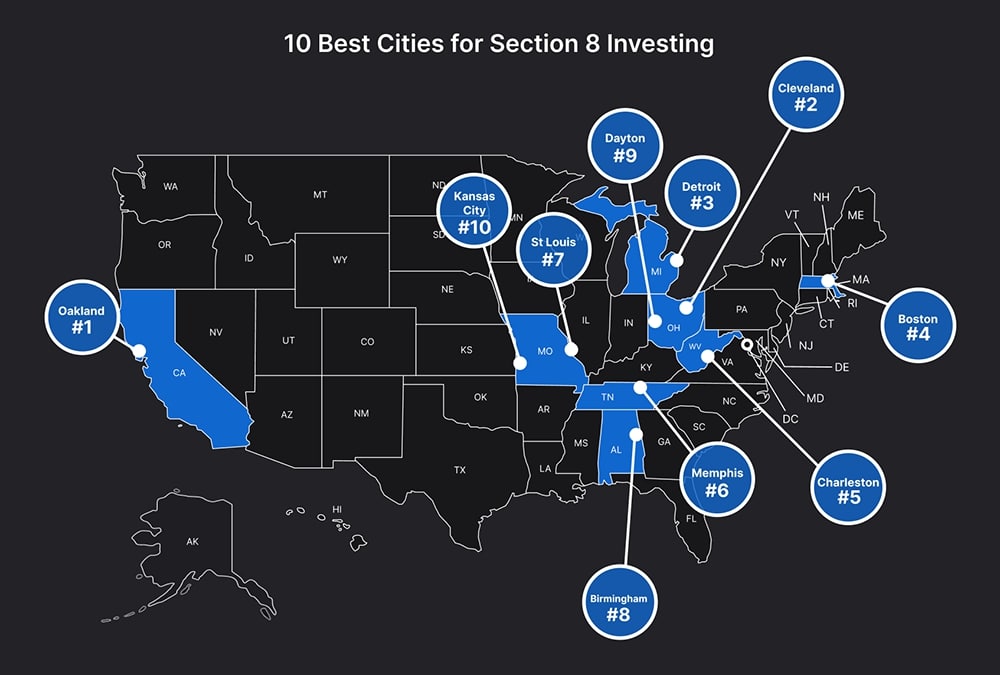
The following list is based on rental income potential, demand, supply, and strategic advantages. We’ve mentioned some of these cities already, but here’s a closer look at their potential, plus other cities that may be particularly attractive for Section 8 investors.
Oakland, CA: High rental income with Section 8 rents at $2,729 for 2-bed, $3,607 for 3-bed, and $4,294 for 4-bed units. Excellent return on investment (ROI) potential.
Cleveland, OH: Low price-to-rent ratio, strong cash flow, and over 20,000 waitlisted Section 8 applicants make it ideal for long-term investments.
Detroit, MI: Over 1,900 homes under $100K with great early buy-in potential and high Section 8 demand.
Boston, MA: Large low-income population of more than 120,000 households, with significant demand for affordable housing and strong Section 8 returns.
Charleston, WV: Houses 45.1% of low-income households, presenting a robust Section 8 investment market.
Memphis, TN: Affordable housing combined with stable cash flow, demand, and resilience during times of economic uncertainty.
St. Louis, MO: Affordable real estate paired with high rental income and a significant number of voucher holders ensure steady demand.
Birmingham, AL: Strong rental income potential in affordable housing with market resilience during economic downturns.
Dayton, OH: Emerging market for profitable rental property opportunities, with resilience against economic shocks.
Kansas City, MO: Relatively low property prices, strong demand for affordable housing due to a significant portion of the population needing housing assistance.
These cities combine rental demand, affordability, and housing market growth for investors looking to enter Section 8 housing markets.
20 Cities With the Highest Fair Market Rents
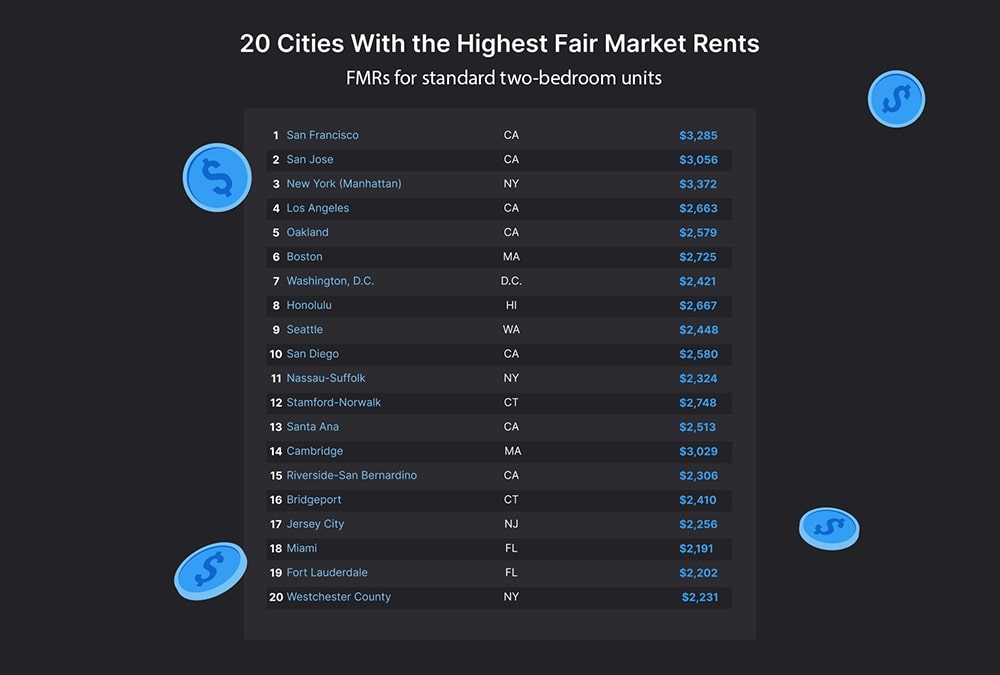
FMR is the standard set by HUD for the maximum amount Section 8 will pay for a unit in a specific area. Here are the 20 cities with the highest FMRs for standard two-bedroom units, based on the latest data from the HUD.
San Francisco, CA – $3,285
San Jose, CA – $3,056
New York, NY (Manhattan) – $3,372
Los Angeles, CA – $2,663
Oakland, CA – $2,579
Boston, MA – $2,725
Washington, D.C. – $2,421
Honolulu, HI – $2,667
Seattle, WA – $2,448
San Diego, CA – $2,580
Nassau-Suffolk, NY (Long Island) – $2,324
Stamford-Norwalk, CT – $2,748
Santa Ana, CA – $2,513
Cambridge, MA – $3,029
Riverside-San Bernardino, CA – $2,306
Bridgeport, CT – $2,410
Jersey City, NJ – $2,256
Miami, FL – $2,191
Fort Lauderdale, FL – $2,202
Westchester County, NY – $2,231
Why High FMRs Can Be Good for Section 8 Investors
A high fair market rent is generally better for Section 8 investors, as it increases the potential rental income that can be earned from a property. The higher the FMR, the more landlords can charge for rent while still having the full amount subsidized by the Section 8 voucher program.
Maximizing rental income can improve profitability and cash flow. This leads to better ROI because the rent is more likely to cover property expenses like mortgage payments, taxes, insurance, and maintenance costs.
Higher FMRs can also allow tenants with Section 8 vouchers to afford housing in more desirable areas, which tend to have better amenities, schools, and employment opportunities. For landlords, this can lead to higher demand, more stable tenants, and lower vacancy rates.
Drawbacks of Low FMRs
While there are plenty of positives for Section 8 investors when it comes to high FRMs, there are also negatives:
Low FMRs limit the amount of rent a landlord can charge, which can result in rental income that is too low to cover property-related expenses.
There can be fewer investment opportunities, as low FMRs are often found in areas with lower property values, and these areas may have weaker rental markets, lower demand, and a higher risk of vacancies.
Areas with low FMRs may be in less desirable neighborhoods, which can lead to higher tenant turnover, property damage, and other management challenges.
Vacancy Rates – State-by-State Breakdown and Trends
Evaluating an area’s vacancy rates can help Section 8 investors gauge demand for rental properties. Generally, a low vacancy rate points to higher demand, as this indicates tenants want to rent properties in the area.
The following map is a breakdown of rental vacancy rates nationwide, based on the latest data from the U.S. Census Bureau. It should be noted that seasonal rentals such as Airbnbs comprise 22.7% of rental units and are excluded from these figures.
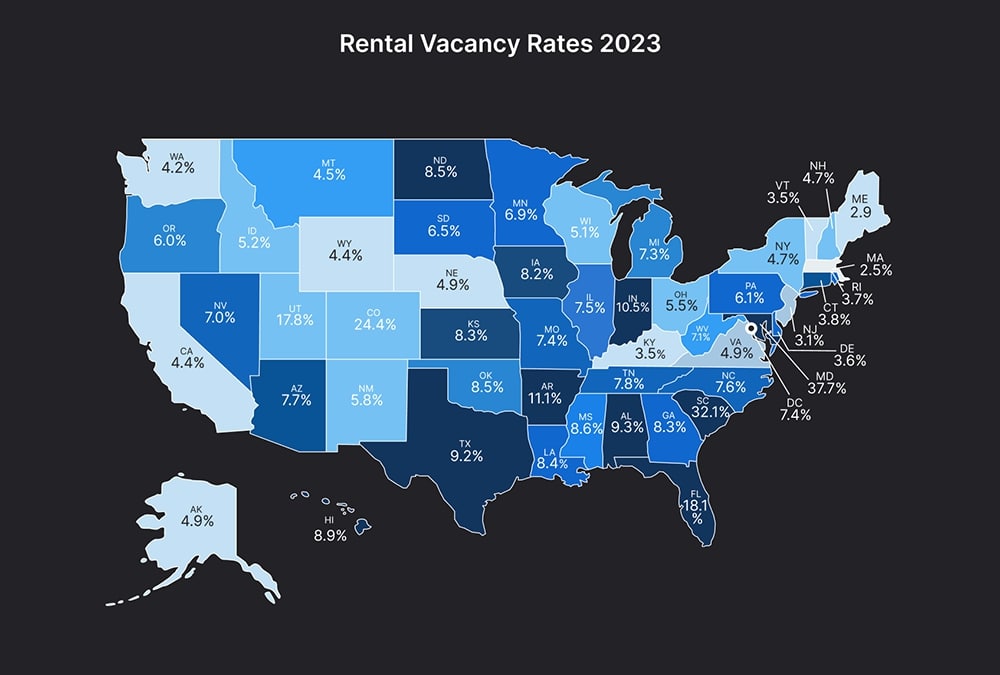
For insight into vacancy trends, here’s how statewide vacancy rates have changed across America year-over-year:
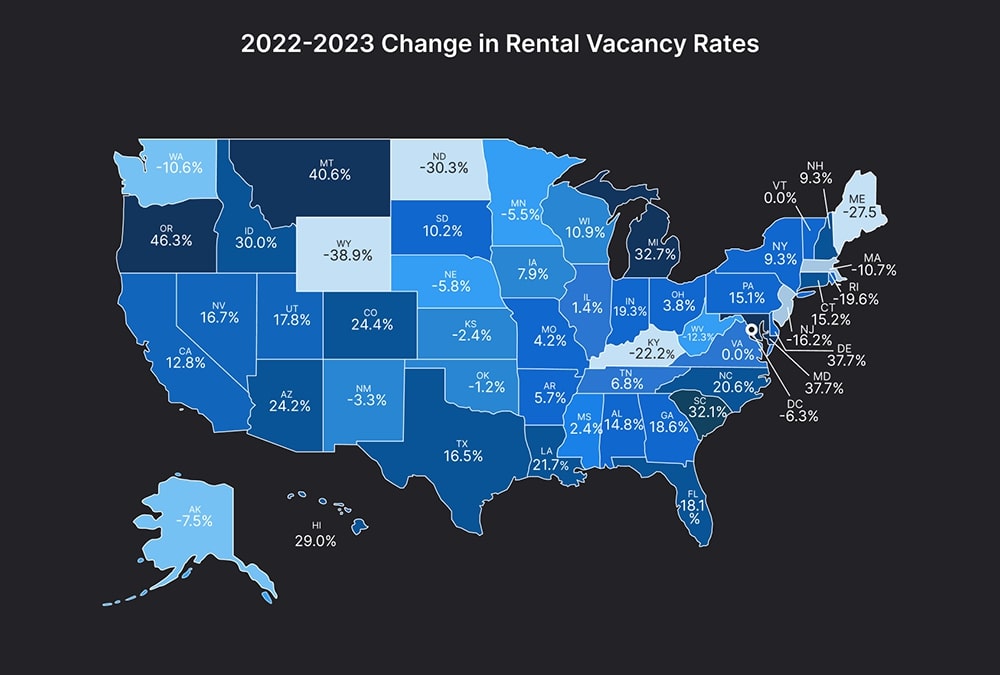
Vacancy rates for specific areas can be determined by analyzing local housing market data and rental statistics. For example, The U.S. Census Bureau provides rental vacancy rates at the state, metro, and local levels through its Housing Vacancy Survey, and HUD offers local market reports and fair market rent data that reflect demand and occupancy trends.
Additionally, real estate platforms like Zillow, Rent.com, and Realtor.com provide vacancy rates and market insights for specific areas, and local housing authorities can offer further insight into Section 8 demand, such as waitlist lengths and voucher distribution.
Section 8 Waitlists – How to Know if Applications Are Open and What That Means for Investors
Waitlists for Section 8 vouchers are divided by county, and generally it takes up to one year or more than five years for an applicant to receive their voucher. Once they receive a voucher, in most cases they have just two to four months to find housing that meets HUD requirements.
An interactive map showing a complete breakdown of Housing Choice Voucher Program waiting lists for all 3,143 U.S. counties, including demographic data, is available here.
However, counties sometimes close applications for Section 8 vouchers for various reasons. To check the status of the waitlist and relevant opening and closing dates for a specific county, consult resources like Affordable Housing Online.
When Section 8 voucher applications are closed, it can create both challenges and opportunities for investors in Section 8 properties. Here's a breakdown of the implications:
Challenges
Limited new tenants: With applications closed, no new Section 8 tenants can join the program in the area, meaning fewer potential renters who can pay with a Section 8 voucher. This could limit the pool of tenants eligible for Section 8 housing, making it more competitive to attract tenants already holding vouchers.
Long waitlists: In areas where applications are closed, it’s often because the waitlist for vouchers is extremely long. This could result in tenants holding onto vouchers longer due to the limited availability of new vouchers, making it difficult for property owners to bring in new tenants if current tenants move out.
Potential vacancy issues: If an investor’s current Section 8 tenants leave and the waitlist is extensive, filling vacancies with other Section 8 tenants could become harder. This might lead to longer vacancy periods, impacting cash flow.
Opportunities
Stable rent payments: If the local Section 8 program has a waitlist, existing voucher holders tend to stay in their rental housing for extended periods. For investors, this can mean more long-term tenants and a stable source of rent payments, which is covered mostly or entirely by the government.
High demand for housing: Closed applications often signal high demand for affordable housing in the area. Investors who already have Section 8 properties could see consistent demand from existing voucher holders, which keeps vacancy rates low.
Potential for rent increases: In high-demand areas where Section 8 applications are closed, the local housing authority may adjust fair market rents upward to align with market conditions. This can allow investors to raise rents within the program, improving profitability.
While closed Section 8 voucher applications can pose challenges by limiting the availability of new tenants, they can also create stability for investors who already have long-term, reliable renters. Investors need to carefully consider the local market and demand dynamics to ensure they are positioned to benefit from these conditions.
Landlord-Tenant Laws
Here’s a general ranking of U.S. states based on how favorable their landlord-tenant laws are for landlords. This list includes considerations for eviction processes, rent control, and property regulations.
While this is a general guide, individual cities or local jurisdictions can have their own rules that differ from state laws.
Texas – Fast eviction process, no rent control.
Indiana – Landlords can terminate leases easily, minimal regulation.
Georgia – No rent control, easy eviction.
Arizona – Landlord-friendly eviction laws, moderate regulations.
Florida – No rent control, quick eviction process.
Colorado – Short eviction timelines, low tenant protection.
Kentucky – Favorable eviction processes, few tenant protections.
Alabama – No rent control, limited tenant defenses.
North Carolina – Streamlined eviction, minimal housing regulations.
Missouri – Favorable eviction timelines, fewer tenant protections.
Arkansas – Weak tenant protections, landlord-friendly.
Idaho – No rent control, easy eviction.
Mississippi – Limited tenant rights, simple eviction processes.
Ohio – Favorable eviction policies, tenant responsibilities are emphasized.
Nevada – Fast eviction process, limited tenant defenses.
Utah – Streamlined processes for landlords, no rent control.
South Carolina – Simple eviction processes, minimal tenant protections.
Oklahoma – Favorable toward landlords in lease agreement violations.
Tennessee – Limited tenant rights, few rental regulations.
Louisiana – Simple landlord obligations, quick evictions.
Michigan – Moderate protections for landlords, easy eviction.
Kansas – Evictions can be processed efficiently, less tenant-focused regulations.
Iowa – Few tenant protections, landlord-friendly eviction process.
Wisconsin – Limited tenant defenses, efficient court systems.
West Virginia – No rent control, landlords have strong rights.
Nebraska – Favorable landlord rules on eviction, few tenant laws.
South Dakota – Streamlined eviction laws, moderate regulations.
North Dakota – Simplified tenant-landlord rules, quick evictions.
Wyoming – Minimal rent control, landlord-friendly eviction processes.
Virginia – Limited tenant protections, straightforward eviction process.
Delaware – Few tenant regulations, landlord-friendly rent rules.
Alaska – Balanced laws, but still favorable for landlords in disputes.
New Hampshire – Strong landlord protections on rent, eviction processes.
Montana – Moderate laws, landlord rights slightly favored.
Maine – Simple eviction policies, landlord-friendly rules.
Vermont – Eviction process is landlord-friendly but tenants have protections.
New Mexico – Moderate tenant rights, easy eviction process.
Minnesota – Some tenant protections but eviction rules are landlord-friendly.
Pennsylvania – Balanced, but landlords have the upper hand in many disputes.
Rhode Island – Moderate tenant protections, landlords can enforce leases easily.
Illinois – Tenant protections exist but many favor landlords.
Washington – Rent control laws and tenant protections present.
Hawaii – High tenant protections, stringent eviction laws.
Maryland – Tenant protections are increasing, slow eviction processes.
Massachusetts – Strong tenant protections, hard eviction process.
Connecticut – Strong rent control, strict tenant protections.
New Jersey – Rent control, tough eviction laws.
New York – Rent control and tenant protection laws heavily favor tenants.
Oregon – Strict rent control laws, tenant-friendly eviction protections.
California – Strong rent control laws, high tenant protections, slow eviction process.
Of course, it’s important to check the relevant state’s landlord-tenant laws in detail before investing. And keep in mind that policies like eviction processes, rent regulation, and property rights may shift over time with changes in legislation.
Final Thoughts
In this article, we explored the 10 best states to invest in Section 8 housing, as well as some of the best cities. We highlighted key factors like local fair market rents, vacancy rates, voucher waitlists, and landlord-tenant laws.
While states like Texas, Florida, Georgia, Ohio, and Tennessee emerged as top choices due to strong demand, favorable regulations, and consistent rental income opportunities, it's important to remember that Section 8 investing can be lucrative in any state, depending on specific market conditions and investor goals.
Each market has its pros and cons, making thorough due diligence essential. By carefully evaluating these factors, investors can make informed decisions and find success in Section 8 housing investments.
If you want to learn more about the program and the related opportunities and challenges for property investors, our complete guide to Section 8 investing can offer valuable insights.
How Recession Proof Blueprint Can Help
Section 8 and HUD programs play a key role in expanding affordable housing options for low-income families, while offering property investors steady, government-backed rental payments.
Becoming a Section 8 landlord can be a highly profitable venture, but it also comes with unique challenges – even if you plan to invest in a state with ideal conditions for Section 8 investors.
Whether you’re a seasoned investor or just exploring Section 8 opportunities for the first time, Recession Proof Blueprint provides the knowledge and tools to navigate the process. From maximizing rental income to managing tenant relationships, we can help you make informed decisions and increase your returns in the Section 8 market.
Schedule a strategy session today.

